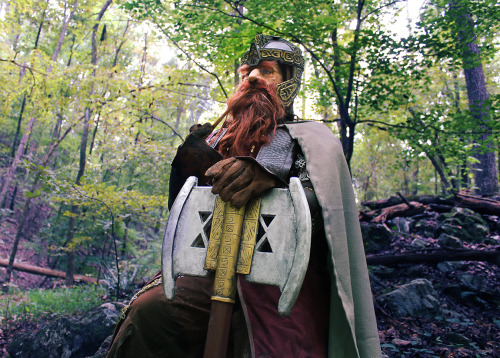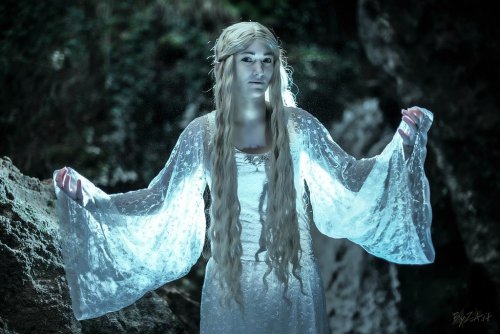#elvish
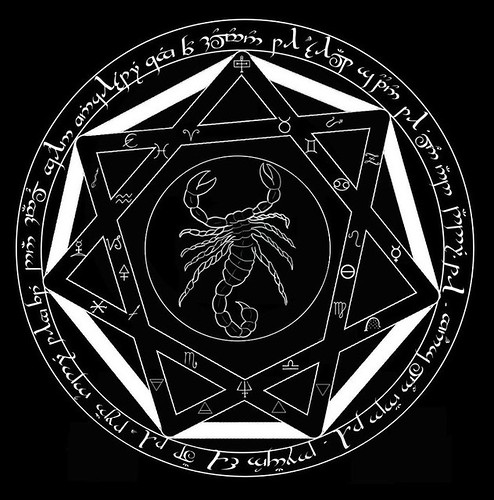
Great treasure hunt!!
I found yet another Devil’s Trap and this one - which is more elaborated - looks a lot more like those used on the earlier seasons of Supernatural (e.g. the one the Winchester boys used to hold Meg down on Season 1, if I’m not mistaken).
The awesome thing about this one, though, is the fact that it has Fëanorian Tengwar inscriptions on it.
How cool is this??
I SOOO want to be highly fluent at this.Manen quetin ya nal ilqua nin?
Resolutionby Michael Färber
Via Flickr:
Follow Me: FacebookBehance
I recently wondered if there was a way to visualise some aspects of the phonological character of Quenya and Sindarin, and the differences between them. The following charts are based on the Namárië poem for Quenya and The King’s Letter for Sindarin. I did a broad phonological transcription for both, then ran frequency counts and relative frequencies on the phonemes. And here are some of the results!
1. Tolkien liked his alveolar stops! And whilst Quenya shows a preference for voiceless stops over voiced stops, the reverse is true of Sindarin.
Part of the reason why the Sindarin voiced stops are so prevalent is due to the extensive consonant mutation system of Sindarin. In the case of stop consonants, the soft mutation turns voiceless stops into voiced stops in certain phonological and/or grammatical environments.
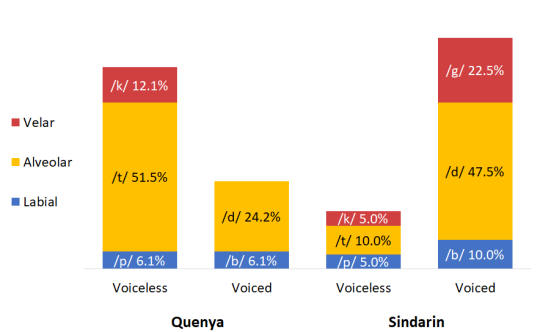
2. Both Quenya and Sindarin prefer front vowels over back vowels, i.e. /i/ and /e/ are preferred over /u/ and /o/ (the Sindarin text happened not to have /u/ at all). The low vowel /ɑ/ is the most frequent vowel in both languages.
Tolkien wrote that in Quenya, the vowel sign for /ɑ/ was often left out in writing, e.g. calma ‘lamp’ could be written as clm (using the equivalent Elvish characters, of course!).

3. Quenya seems to be more vowel-heavy than Sindarin, but Sindarin’s consonants seem to have a larger proportion of liquids, nasals and fricatives … and Sindarin /n/ and /r/ are super-popular!
Almost half of the phonemes shown for Quenya are vowels, compared with two-fifths in Sindarin. As Tolkien wrote, Quenya words more often ended in a vowel, whilst those in Sindarin more often ended in a consonant.
In Sindarin, about two in seven phonemes (of those shown in the chart) is either /r/ or /n/! In Quenya, /n/ appears about twice as often as /m/, but in Sindarin, /n/ appears about seven times more often than /m/!
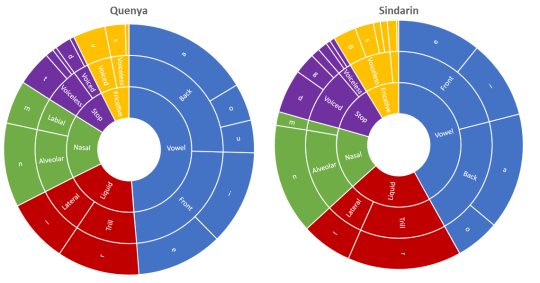
A secret vice - this was how J.R.R. Tolkien described his love of creating, crafting and changing his invented languages. With the popularity of his books and the modern film adaptations, the product of this vice is no longer as ‘secret’ as it once was – almost everyone will have heard of Elvish by now; some will have heard of Quenya and Sindarin; and a small number will have heard of more besides …
I started thinking about the theme of this post having read this article from the Guardian on constructed languages (or ‘conlangs’):
Conlangs can be used to add depth, character, culture, history among many other things, but I think that Tolkien’s invented languages are in a class apart from other famous invented languages, e.g. Klingon, Na’vi, Dothraki, Esperanto, etc.
What many people don’t know is that Tolkien’s Elvish languages weren’t ‘invented for’ the Lord of the Rings, or the Hobbit or even what was to become the Silmarillion. In fact, in many ways it is more accurate to say that these stories and legends were invented for the Elvish languages!
Tolkien’s Elvish languages began to grow at about the time of the First World War, and they continued to grow for the rest of Tolkien’s life. Tolkien gave to two of these languages, Sindarin and Quenya, the aesthetic of two of his favourite languages, Welsh and Finnish respectively. However, rather than develop comprehensive dictionaries and grammars of the Elvish languages, Tolkien approached their invention from a primarily historical and philological perspective – something that the other famous conlangs do not do to anywhere near the same extent.
Sindarin and Quenya were designed to be natural languages, i.e. languages with their own irregularities, quirks and oddities (like real-world languages) but whose peculiarities would make sense when looked at from a historical linguistic perspective. Furthermore, Sindarin and Quenya are related languages, i.e. they share a common (and invented!) ancestor. Whenever Tolkien compiled anything like a dictionary, it was more akin to an etymological dictionary or a list of primitive roots and affixes. He would build up a vocabulary using these roots and affixes then submit the results to various phonological changes (as well as language contact effects, borrowings, reanalyses, etc thrown in for good measure! Did you know that the Sindarin word heledh ‘glass’ was borrowed from Khuzdul (Dwarvish) kheled?). The result is a family of related languages and dialects.
But these languages and dialects needed speakers, and their speakers needed a history and a world in which this history could play out. Tolkien believed that language and myth were intimately related – the words of our language reflect the way we perceive the world and myths embody these perceptions and are couched in language, yielding a rich melting pot of associations. To appreciate something of what Tolkien might have felt consider the English names for the days of the week or the months of the year. Why do they have the names they do? What does this tell us about our heritage and cultural history? What does it say about what we used to think and feel about the world? Now imagine thinking like this about other words … I found out earlier this week that English lobster is from Old English lobbe+stre ‘spider(y) creature’ (incidentally, lobbe ‘spider’ provided Tolkien with the inspiration for Shelob, the giant spider from The Two Towers (or, if you’re more familiar with the films, The Return of the King)). That is the kind of philological delight Tolkien wanted Sindarin and Quenya to have, and they do (nai elyë hiruva)!
@yuno.okumura took so many beautiful photos of this Moon Goddess wall decor I made for her and I can’t wait to show you all of them… This is my new “special offer” project in addition to my pendants. I’ve already made two more which I’ll share to my story feed, but they are still -wip-.✨ I have to admit I’m having so much fun making them and am feeling very inspired.. I’ve also made four Elvish pendants which will be available soon. They are all different but with two recurring elements: Elvish trees and crescent moons. And of course, sparkly Czech glass beads. ✨
#FaeErynethsTreasures #faery #fairy #faeries #sculpting #polymerclay #handmade #homedecor #walldecor #enchanting #magick #elvish #elven #elvesofinstagram #enchantedhome
https://www.instagram.com/p/B8ZX8XlnEP8/?igshid=wsjxmjwsy62i
Post link

Redraw of an artwork from 2019 of my character Rhëa Garwen D'Hâl ✨

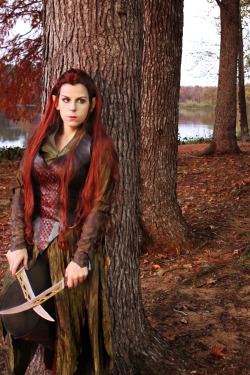



Celtic Ruins Designs as Tauriel
Last two pictures were taken on the North Island of New Zealand, on the foothills of Mt. Ruapehu; the volcano next to Mt. Doom, and where Emyn Muil was filmed!
https://www.facebook.com/CelticRuinsCostumes
Submitted by celticruinsdesigns






Gorgeous Galadriel cosplay submitted luciaskyghidetti!
We celebrated the last day of Tolkien week, with a Legolas/Gimli romp in the woods!
Legolas and Gimli costumes by me
Gimli prosthetics, hair work and props by me
Our awesome friend Howie helped us set up these shots and manned the camera for us! We have great friends, indeed.
Wanna see more of my work? Visit my FB page and give it a like if you feel so inclined:https://www.facebook.com/CelticRuinsCostumes
Post link
This was my first time cosplaying and I think I did a pretty good job ^___^
(Submitted by: marjoleinhoekendijk)
Post link
You will give me the Ring freely! In place of the Dark Lord you will set up a Queen. And I shall not be dark, but beautiful and terrible as the Morning and the Night! Fair as the Sea and the Sun and the Snow upon the Mountain! Dreadful as the Storm and the Lightning! Stronger than the foundations of the earth. All shall love me and despair!
Galadriel cosplay by luciaskycosplay!
Twitter: twitter.com/Miss_Sky_Marble
WorldCosplay: worldcosplay.net/member/Sky
Tumblr: luciaskyghidetti.tumblr.com/
Post link
3 Elven Themes in Nature Ambience | calm & peaceful music with elvish co…
Yavanna, áva hehta eldalyar! - the elven song to the Valië of Earth …
I already miss summer.






